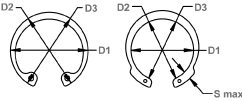Inspection Procedures: Internal Retaining Rings
Determining Permanent Set Limits for Basic Internal Retaining Rings
HO, VHO, HOI
1. Measure thickness (designated as “T” in specification charts) of the ring for adherence to specified tolerances.
2. Using a Rotor Clip retaining ring plier, compress the lugs fully until they touch. Repeat this procedure four additional times using the same ring. Examine the ring for cracks.
3. Measure ring diameter (D) in three directions as indicated below.

4. FOR HO AND VHO RINGS–Take the results of these three measurements and compute the average. Compare this figure to the maximum groove diameter listed in the specification chart for HO and/or VHO rings. If the average diameter after permanent set is GREATER than the groove diameter, THEN THE RING IS FULLY FUNCTIONAL AND WILL PERFORM ACCORDING TO STATED SPECIFICATIONS:
Average Diameter > Maximum Groove Diameter (“Dg” in Spec Chart)
5. FOR HOI RINGS – Take the results of the three diameter measurements described in #3 above and compute the average. Measure the maximum section (“S Max.” in the spec charts). Compare the average diameter plus 2 times “S Max” to the maximum groove diameter listed in the specification chart for HOI rings. If the average diameter plus twice the maximum section after permanent set is GREATER than the groove diameter, THEN THE RING IS FULLY FUNCTIONAL AND WILL PERFORM ACCORDING TO STATED SPECIFICATIONS:
Average Diameter + 2S Max > Maximum Groove Diameter (“Dg” in Spec Chart)
More than Parts. A True Partnership.
Our passion is creating the best rings, springs, and clamps. Our mission is to make your work a success. We are here for you.
